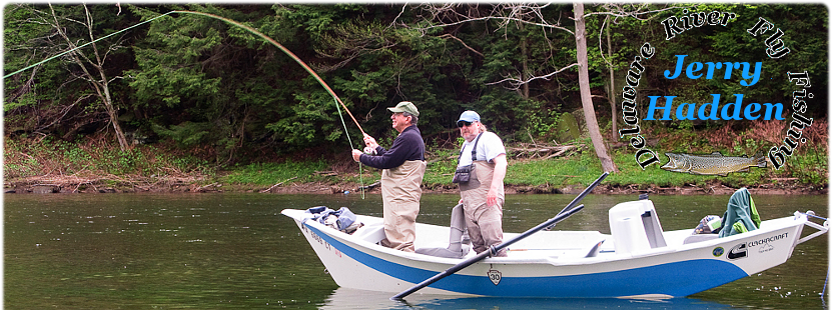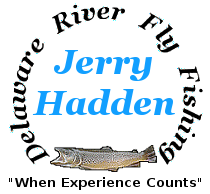
Ephemerella subvaria
Hendricksons
Jerry Hadden

Photo taken from a drift boat by Jerry Hadden
The Hendrickson hatch is usually the first important hatch of the year. The weather is finally beginning to break, and trout that havent been fished over for six months or so, begin feeding freely. Not being fished to for this long the wild Delaware trout are for the time unsuspecting of the anglers imitation. Making these highly selective trout a bit easier to fool with a good imitation.
On the Upper Delaware river Ephemerella subvaria (Hendricksons) normally begin hatching sparsely in the second or third week in April, and hatching in great numbers by mid May with the mean being May 10th. The heaviest hatch activity falling between May 10th to the 20th. In the last three years low water flows from the Cannonsville (Thanks to New York City Water and their new valves.) combined with the warmer winters have greatly accelerated nymph growth in the upper Delaware. Remembering that mayfly nymphs are cold-blooded creatures, their growth rate is directly dependent on water temperature. (Within reason, water that is to warm will kill the cold water insects and warmer water insects will become dominant, but thats a long story in itself.) So with warmer year round water temperatures nymphs mature faster, and the Hendrickson hatches have been considerably early, a month to be precise. Fly fisherman traveling to the upper Delaware expecting to fish the large Ephemerella subvaria hatches are finding they are to late, instead of catching the Hendricksons at prime time they're already finished for the season.
Nymph

A Generic Brown Nymph
Photo by Jerry Hadden
Hendrickson nymphs are generally dark brown in color. A good match for the naturals would be a dark brown body dubbed from either natural or synthetic dubbing in sizes 12, 14, and 16. Dark grouse body feathers for the tail and legs, with a turkey tail wing Case.
In the high cold spring water anglers should find success by fishing these nymphs down deep and slow along the river bottom, concentrating on pocket water in moderate to fast running riffles.

Pheasant Tail Nymph
A pheasant tail also works well, but proves to be less durable when fished deep, scraping and bouncing on the river bottom.

Hendrickson emerger
During the beginning of the days Hendrickson hatch an emerger pattern can be deadly. The emerger should be fished dead drift just as the dun.

Male Ephemerella subvaria.

Female Ephemerella subvaria.
Ephemerella males have large round eyes while the female's eyes are much smaller.
Like most mayflies the duns come in two different colors, the dark reddish brown male, and a light tan female. Both sporting medium to dark dun wings, segmented legs and three tails. Duns usually begin hatching when the water temperature reaches close to 50 degrees, and generally continue hatching regardless of the weather conditions. Hatches begin during the warmest time of the day usually mid afternoon, somewhere between 1:00 and 3:00PM. The subvaria hatch normally lasts between one and half to two weeks. During this time the large size 14 & 12 or the true Ephemerella subvaria begin hatching first. Within two weeks the smaller size 16 - 18 Ephemerella x start to appear, this signaling the beginning of the end of this fabled hatch.

Male subvaria Spinner
As the evenings begin to warm to around 70 degrees or so Ephemerella subvaria spinners begin to arrive on the scene. These early spinner falls can either be some of the year's best fishing or a bust. What a bust, yes a bust I've spent a number of evenings on the river waiting for the spinner fall to begin only to be disappointed.
Picture this it's a nice sunny early spring afternoon with plenty of insect activity, as evening begins a large mating swarm form in the warm sunlight over the river. The air temperature quickly drops over the cold river water as the sun begins to move away from the water, taking the spinners along with it. The spinners follow the warm sun and fall somewhere in a field or woods rather than the water.
Ephemerella subvaria spinners are dark reddish brown in color, size 14 & 16. Good spinner imitations are the Lady Beaverkill representing the female spinner, and a red quill representing the male spinner. I prefer to fish a poly wing spinner, dark reddish brown in color for the male, adding an egg sack to imitate the female.

Poly Spinner
Fishing during a good spinner fall can be some of the seasons best as large fish feeding freely on the newly spent flies.
In general Ephemerella subvaria, weather fishing nymph, emerger, dun, or spinner provides some of the seasons best fishing. Don't miss it by relying upon books, that try to dictate when and where this hatch will begin for the season. The insects don't read, nor do the fish. Use some common sense in regard to the weather conditions.
More information on Ephemerella subvaria can be found here

Click Here
Wet Flies Work
Click Here
Quill Gordons
Click Here
 Delaware River Fly Fishing
Delaware River Fly Fishing
